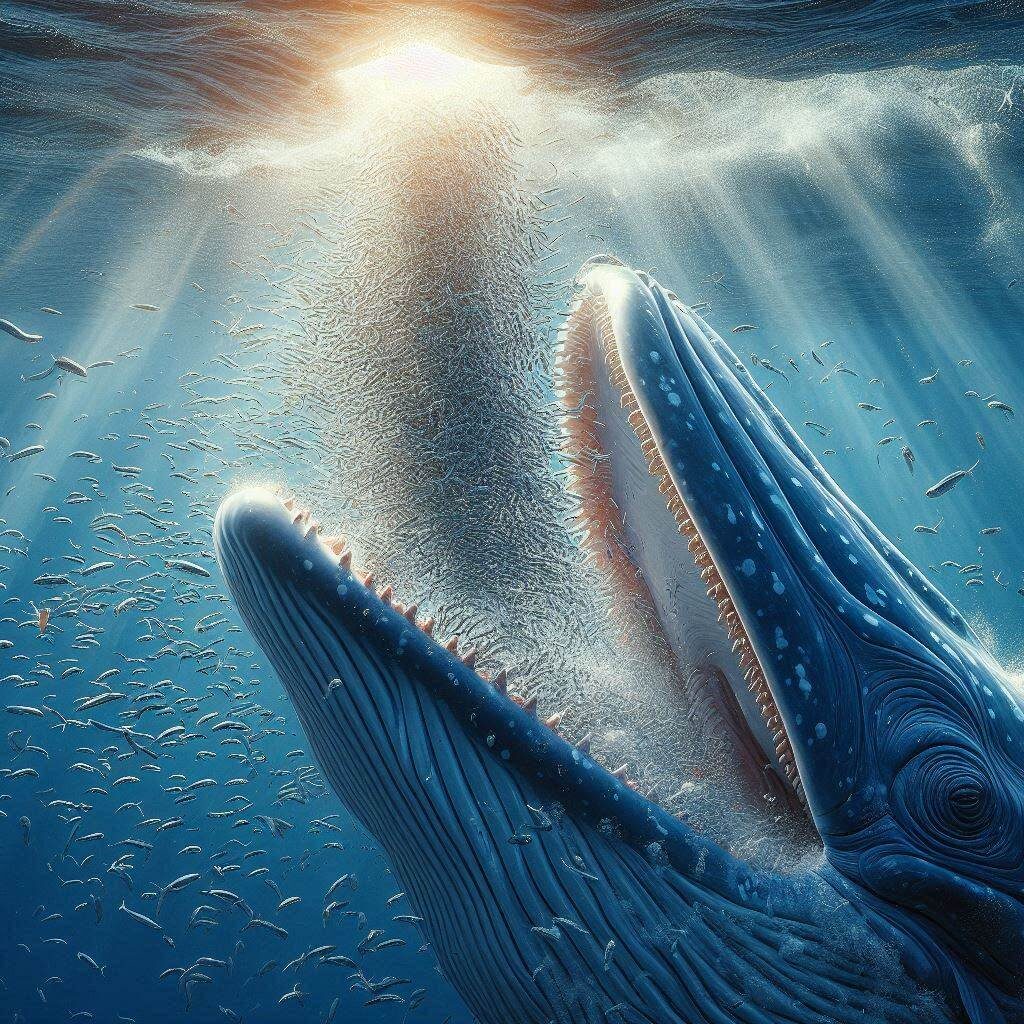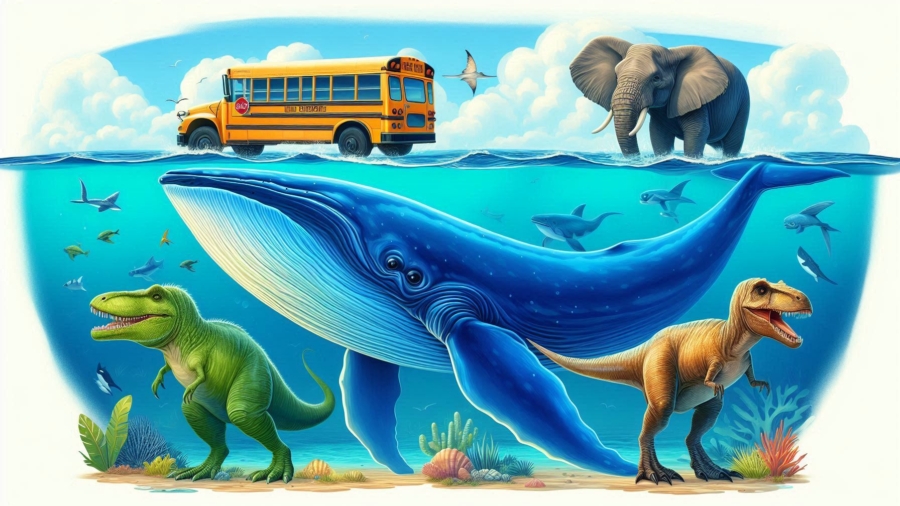Imagine an animal so colossal, its heartbeat can be heard two miles away. An animal whose tongue weighs as much as an elephant and whose veins are wide enough for a human to swim through. Meet the blue whale—the undisputed heavyweight champion of the planet.
This gentle giant isn’t just the largest animal in the world today; it’s the biggest creature ever to exist, dwarfing even the mightiest dinosaurs. But how did it get so huge? Why does it matter? And what can we learn from its story?
In this deep dive, we’ll explore:
- The blue whale’s mind-blowing size (with comparisons to everyday objects).
- Why it’s bigger than T. rex, Argentinosaurus, and modern giants like elephants.
- How it eats, communicates, and survives in the ocean.
- The threats it faces—and how we can help.
Ready to be amazed? Let’s dive in!
1. What is the Largest Animal in the World?
The blue whale (Balaenoptera musculus) holds the title of largest animal in the world—and the largest creature in Earth’s history. Here’s what makes it a record-breaker:
Size Breakdown
- Length: Up to 100 feet (30 meters)—longer than three school buses parked end-to-end.
- Weight: A staggering 200 tons (400,000 pounds). That’s equal to:
- 33 African elephants.
- 2,500 average-sized humans.
- 1,600 grand pianos!
- Heart: Weighing 1,300 pounds, it’s the size of a small car and pumps 60 gallons of blood per beat.
Fun Fact: A blue whale’s spout (the water spray from its blowhole) can shoot 30 feet into the air—taller than a giraffe!
Baby Blue Whales: Giants from Day One
Even newborn blue whales are enormous:
- Birth Length: 25 feet (as long as a pickup truck).
- Weight Gain: They drink 50 gallons of milk daily, gaining 200 pounds every 24 hours.
- Childhood: By six months, they’re 50 feet long and ready to hunt krill on their own.
2. Blue Whale vs. Dinosaurs: Who’s Bigger?
Movies like Jurassic Park make dinosaurs seem unbeatable, but the blue whale would’t flinch in a size contest. Let’s compare:
The Dinosaur Challengers
- Argentinosaurus (longest dinosaur):
- Length: 115 feet (slightly longer than a blue whale).
- Weight: 70–100 tons—half the weight of a blue whale!
- Weakness: Land-based life limited its size due to gravity.
- T. rex:
- A mere 40 feet long and 9 tons—tiny compared to a blue whale!
Why Water Beats Land for Growing Giant
- Buoyancy: Water supports massive bodies, letting whales grow without collapsing under their weight.
- Food Supply: Oceans offer vast amounts of nutrient-rich krill, unlike scarce land vegetation for dinosaurs.
Pro Tip: Visit a natural history museum to see blue whale skeletons, like the famous “Hope” at London’s Natural History Museum. Standing beneath it feels like staring up at a living skyscraper!
3. How Do Blue Whales Eat? A Krill Buffet!

Blue whales are filter feeders, and their diet is key to their size. Here’s how they devour tons of food daily:
Step 1: The Hunt for Krill
- Krill: Tiny shrimp-like creatures that swarm in groups called “clouds.”
- Daily Intake: 4 tons of krill (8,000 pounds)—equal to eating 40,000 Big Macs!
Step 2: The Gulping Strategy
- Accelerate: Blue whales surge forward, mouth wide open.
- Engulf: They take in 17,000 gallons of water and krill—enough to fill a school bus!
- Filter: Push water out through baleen plates (bristly filters), trapping krill.
- Swallow: The krill slide down their throat (which is only as wide as a basketball).
Fun Fact: A blue whale’s mouth has grooves that expand like a parachute to hold extra water.
Why Not Bigger?
Scientists believe blue whales hit an evolutionary “size limit.” To grow larger, they’d need more krill than the ocean can provide!
4. Blue Whale vs. Modern Giants
Let’s see how the blue whale compares to today’s largest animals:
| Animal | Length | Weight | Cool Fact |
|---|---|---|---|
| Blue Whale | 100 feet | 200 tons | Heartbeat detectable 2 miles away. |
| African Elephant | 13 feet tall | 7 tons | Eats 300 pounds of food daily. |
| Whale Shark | 40 feet | 20 tons | Largest fish, but no match for whales! |
| Colossal Squid | 46 feet | 1,500 pounds | Eyes as big as dinner plates. |
Key Takeaway: The blue whale is 10 times heavier than the largest land animal and twice as long as the longest shark!
5. Why Are Blue Whales So Loud?

Blue whales are the loudest animals on Earth—even louder than jet engines! Here’s why:
The Science of Whale Songs
- Volume: Their calls reach 188 decibels (jets are 140 dB).
- Purpose: Males sing to attract mates, communicate, and navigate.
- Range: Songs travel 1,000+ miles underwater, letting whales “talk” across oceans.
Fun Comparison: If a blue whale screamed in your ear, it could rupture your eardrums. Thankfully, they stick to the deep sea!
6. Blue Whales and the Ecosystem

Blue whales aren’t just big—they’re vital to ocean health. Here’s how:
The “Fertilizer” Effect
- Waste: Whale poop is rich in iron and nitrogen, which fertilize phytoplankton (tiny ocean plants).
- Phytoplankton: These plants produce 50% of Earth’s oxygen and absorb CO2.
Translation: Protecting whales helps fight climate change!
Food Chain Impact
- Krill Control: By eating millions of krill, whales prevent overpopulation that could destabilize the food web.
- Scavenger Support: When whales die, their carcasses (“whale falls”) feed deep-sea creatures for decades.
7. Why Are Blue Whales Endangered?
Sadly, only 10,000–25,000 blue whales remain. Here’s what pushed them to the brink:
History of Whaling
- 1800s–1900s: Whalers killed nearly 3 million whales for oil (used in lamps, soap) and meat.
- Blue Whale Toll: An estimated 97% of blue whales were wiped out by 1960.
Modern Threats
- Ship Strikes: Collisions with cargo ships often prove fatal.
- Fishing Nets: Whales get tangled and drown in ghost nets.
- Noise Pollution: Ship engines disrupt their communication.
- Climate Change: Warming oceans reduce krill populations.
Hope for the Future
- Bans: Commercial whaling banned in 1966 (though some countries still hunt whales).
- Protected Areas: Marine sanctuaries in the Pacific and Atlantic.
- Tech Solutions: Apps like Whale Safe alert ships to nearby whales.
8. How You Can Help Blue Whales
Want to protect these gentle giants? Here’s how:
- Reduce Plastic: Plastic pollution harms krill and whales. Use reusable bags and bottles.
- Support Conservation: Donate to groups like WWF or Ocean Alliance.
- Choose Sustainable Seafood: Avoid brands that overfish krill-based species like salmon.
- Spread Awareness: Share facts about blue whales on social media!
FAQs About the Largest Animal in the World
Q: Could a blue whale swallow a human?
A: No! Their throats are the size of a basketball. They only eat krill.
Q: How long do blue whales live?
A: 80–90 years—similar to humans! Scientists guess their age using earwax layers (each layer = 6 months).
Q: Are blue whales smarter than dolphins?
A: We don’t know! Their brains weigh 15 pounds (twice a human’s), but intelligence is hard to measure.
Q: Do blue whales have predators?
A: Only killer whales attack calves. Adults are too big to hunt!
Conclusion
The blue whale is more than just the largest animal in the world—it’s a marvel of evolution, a climate ally, and a reminder of nature’s fragility. By learning about these gentle giants, we take the first step toward protecting them.
So next time you sip a glass of water, remember: somewhere in the ocean’s depths, a creature larger than any dinosaur glides silently, its heartbeat echoing across miles of sea. Let’s make sure future generations can say the same.

